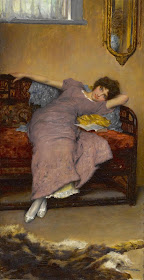Breakspeare could paint competently and was able to made a career as an artist in Victorian and Edwardian times. His subjects tended to be 17th century scenes, pianos and pretty women. And his interpretations of these were conventional most of the time. As is the case for many lesser-known artists, he occasionally could make paintings worth noting.
Here are examples of Breakspeare's paintings.
The Contract
In theory, this might be an illustration or otherwise a reference to literature or an historical event because there is little intrinsic meaning in the depiction.
The Eve of Battle
The same applies here. There is little in the way of the drama or tension I would expect in a real-world pre-battle situation. In this painting, the men at the table seem quite calm and satisfied. The cavalier at the right has a look of concern, but serves no dramatic purpose unless the painting is an illustration of an historical or literary source.
If Music be the Food of Love
Breakspeare usually included pianos where music was part of the action. Here the man seems to be playing an organ.
Distant Thoughts
More of a sketch than a finished work, but interesting in that regard.
Resting
One of his better-known works. Pretty fancy girl for a harvester.
The Alluring Student
Hmm. A piano also beckons.
The Reluctant Pianist
This looks like the same piano and bench, but away from the window.
Blue Eyes
She is the same woman wearing the same dress as in the previous painting.
The End of the Evening
Finally, a scene that's not Victorian. Very Edwardian in spirit, I'd say.









It's a fair point that Breakspeare's paintings lack conviction in their narrative, though his " A good bowl of punch" ( hi-res at ArtrenewalCenter ) is one of his more persuasive images, but I think the work of Meissonier (1815-1891) is more convincing ( and the originals of those I look at in the Wallace Collection - London, are extrordinary given how small they are). Equally it's hard to better Jose Jimenez Aranda ( 1837-1903) for dynamism in his scenes, and his technical skill is masterful.
ReplyDeleteThe last image in your post, 'The End of the Evening' reminds me,unfortunately - to Breakspeare's detriment, of the stunning 'The end of dinner' ( Hi-res on wikimedia) by Jules-Alexandre Grün (1868-1934), which is so vivacious I can 'hear' the painting, a quality I find most gratifying because it's so rare.